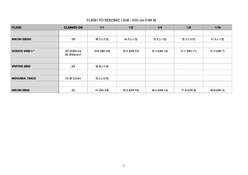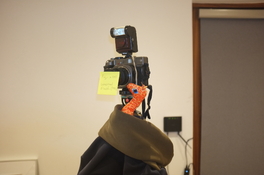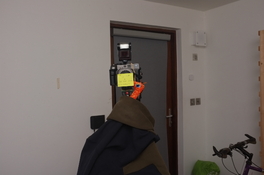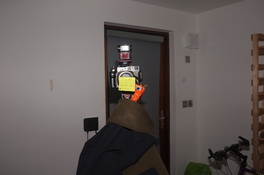That proved my point that flash manufacturers intentionally claimed high output for their flashes than actual. If it's the manufacturing variation then you would find some units deliver more power than specs. So far I have never found one that has actual GN higher than specs,
-
Welcome to Photrio!Registration is fast and free. Join today to unlock search, see fewer ads, and access all forum features.Click here to sign up
You are using an out of date browser. It may not display this or other websites correctly.
You should upgrade or use an alternative browser.
You should upgrade or use an alternative browser.
Nikon SB 800 vs Sekonic L558
-
A
- Thread starter Ardpatrick
- Start date
Recent Classifieds
-
For Sale Nikon FE (blk) w/ 35-70 f/2.8 (Read)
- Started by Acere
-
For Sale FS: Horseman Long Loupe 6X
- Started by B.S.Kumar
-
For Sale FS: Linhof Master GTL / AMS 4x5 Camera
- Started by B.S.Kumar
-
For Sale Four H&Y Magnetic 4" Filter Holders and Four Cokin B&W Contrast Filters
- Started by Steve Goldstein
-
Sold Schneider Kreuznach Super-Angulon 165mm - 8x10
- Started by Guivd
Forum statistics
That proved my point that flash manufacturers intentionally claimed high output for their flashes than actual. If it's the manufacturing variation then you would find some units deliver more power than specs. So far I have never found one that has actual GN higher than specs,
Yes it does, whether intentional or not. But I don't think there are many who ever doubted that fact.
Of the few I've measured, the closest I've found was an elderly pair of Vivitar 285's. I consider them outlayers.

Yes it does, whether intentional or not. But I don't think there are many who ever doubted that fact.
Of the few I've measured, the closest I've found was an elderly pair of Vivitar 285's. I consider them outlayers.
I couldn't find that document any more. I read a pdf by Metz in that they said to test the GN of the flash they use a 50% reflectance surface and with the meter in reflected light mode. If that the case then the flash would meet the specs with 1.5 stop less power.
I don't recall that documetn or the use of reflected light mode, but will look through my files to see if I can find it, or something like similar.
Ta add some data to the discussion... SB-16 measured with Sekonic L-558. Meter sensor, incident, and flash at 10 feet separation with same XYZ angles (handheld). ASA 100. MANUAL mode only. Flash popped after about 1 min after signalling full charge. Each flash head focus setting checked; no fractional power offered on this flash. Room was "normal" den with 8 foot white popcorn ceilings. Repeated measures; minimum 6 measures per mode. Nominal measure value reported.
N (35mm)
Spec: GN: 105
Calculator recommended setting: f/8
Flashmeter measurement: f/8
S (50mm)
Spec: GN: 125
Calculator recommended setting: f/8
Flashmeter measurement: f/8
T (85mm)
Spec: GN: 138
Calculator recommended setting: f/8
Flashmeter measurement: f/8
W1 (28mm)
Spec: GN: 89
Calculator recommended setting: f/8
Flashmeter measurement: f/6.3
For the flash head setting I might use in Manual Mode (N, S, and T), it seems that either flashmeter or calculator dial would be accurate. Guide Number, not so much. I find it interesting that published GN seems to disagree with calculator dial in this instance.
Ta add some data to the discussion... SB-16 measured with Sekonic L-558. Meter sensor, incident, and flash at 10 feet separation with same XYZ angles (handheld). ASA 100. MANUAL mode only. Flash popped after about 1 min after signalling full charge. Each flash head focus setting checked; no fractional power offered on this flash. Room was "normal" den with 8 foot white popcorn ceilings. Repeated measures; minimum 6 measures per mode. Nominal measure value reported.
N (35mm)
Spec: GN: 105
Calculator recommended setting: f/8
Flashmeter measurement: f/8
S (50mm)
Spec: GN: 125
Calculator recommended setting: f/8
Flashmeter measurement: f/8
T (85mm)
Spec: GN: 138
Calculator recommended setting: f/8
Flashmeter measurement: f/8
W1 (28mm)
Spec: GN: 89
Calculator recommended setting: f/8
Flashmeter measurement: f/6.3
For the flash head setting I might use in Manual Mode (N, S, and T), it seems that either flashmeter or calculator dial would be accurate. Guide Number, not so much. I find it interesting that published GN seems to disagree with calculator dial in this instance.
Finally I did a test of the output of my SB 800 in manual mode again - inspired by Chan. I also tested a few other flash guns I have to hand, including a Miranda which is the first piece of photo equipment I ever bought and still going strong, in 1987 (Oh if only I'd stopped there!).
Test was done in my regular living room, at 6 metres. I can do it again in feet if easier, and can do it at 10/11 feet as Chan did. This was just spatially convenient.
I did everything at 35mm @ iso 100 - the Vivitar 2800 doesn't have a zoom adjustment but probably covers 35mm. Despite a lot of searching I could not find a manufacturers specified GN number for the Godox at 35mm, although I did find a comment on dPreview extrapolating that it is likely 35 at 35mm. The published spec is 60 at 200mm, at iso 100.
First observation - the SB800 is pretty close to the LCD spec throughout the power settings (always under-exposed according to the Sekonic but not by much). Actual measured output is listed and in brackets the degree of under-exposure compared to the LCD specification.
Second observation - I didn't expect the SB800 to be more powerful than the Godox, a lightly used unit that is about 15 years its junior. The Godox is also physically bigger.
Third observation - The Godox entries only list the output read-out as measured by the light meter. It was late at that point - not sure if I forgot to write in the Godox LCD proposed f-stop, of it doesn't actually list one on the display. I'll clarify later.
The Vivitar and the Miranda only have full output in manual mode. The Miranda has a clunky manual zoom head (the front fresnel can be slid forward) - but the stated GN at the 35mm position is 25.
I will test the SB 800 in auto mode later with a Fuji x100 Mark 1 that I have. Voltage-wise I think it's safe (?). I can use a remote trigger maybe.
The display and your measurement for the SB-800 matches exactly
I attached the display for 1/1, 1/2 and 1/4
Found this ISO standard 1230:2007
Great minds think alike. Yesterday I was seeking "ground truth" on this topic and went through the ISO standards. That standard has part of the story. It is an interesting read for anyone who actualy reads and understands it.
There is, perhaps, more of the story in ISO 2827, which is more extensive in detail. Additionally, in 2827 are the "allowable tolerances" for GN as well as other attributes of flash documentation. The allowable tolerances intriqued me the most, as many of our "complaints" are within those tolerances.
It is important to ntoe that these are voluntary standards and compliance is not required. If a manufacturer complies and verify/validate compliance they can claim that their product "conforms with ISO XXXX"... but that I've nevere seen. It is highly likely, though that the major manufacturers complie but either don't spend the money to verify/validate as that is a rather costly effort, or they know they comply but simply don't include in tehir ads and documentation. Frankly, most wouldn't know what that means or appreciate it if they do. It would be reasonable to believe that they do conform to the ISO standards as tehy are part of the voting body that writes, updates, validates, and approves them.
Don't mind the elderly dates on these two documetns. They are reviewed every 5 years and have been revalidated without changes. They are still active standards.
There is, perhaps, more of the story in ISO 2827, which is more extensive in detail. Additionally, in 2827 are the "allowable tolerances" for GN as well as other attributes of flash documentation. The allowable tolerances intriqued me the most, as many of our "complaints" are within those tolerances.
It is important to ntoe that these are voluntary standards and compliance is not required. If a manufacturer complies and verify/validate compliance they can claim that their product "conforms with ISO XXXX"... but that I've nevere seen. It is highly likely, though that the major manufacturers complie but either don't spend the money to verify/validate as that is a rather costly effort, or they know they comply but simply don't include in tehir ads and documentation. Frankly, most wouldn't know what that means or appreciate it if they do. It would be reasonable to believe that they do conform to the ISO standards as tehy are part of the voting body that writes, updates, validates, and approves them.
Don't mind the elderly dates on these two documetns. They are reviewed every 5 years and have been revalidated without changes. They are still active standards.
Yup! So with the tolerance all of my units meet the specs (but none surpasses the specs). Good to know.
Chan,The display and your measurement for the SB-800 matches exactly
I attached the display for 1/1, 1/2 and 1/4
View attachment 376091View attachment 376092View attachment 376093
The uncanny consistency of our read outs gives me the distinct sense that I mislead everyone on how to read my test results. I think I mis-remembered my entries for the SB800. The first figure (which matches your read-out) is in fact my SB 800 read-out, and the value in brackets is the shortfall from that value at the Sekonic meter! So under-exposure, albeit generally not bad.
I found another flash gun in a box - a Nikon SB-20 flea market special. I tested it the same way, and updated my results here. It's pretty good for a flash from the late 80's. But it doesn't come near its stated GN number.
Attachments
Chan,
The uncanny consistency of our read outs gives me the distinct sense that I mislead everyone on how to read my test results. I think I mis-remembered my entries for the SB800. The first figure (which matches your read-out) is in fact my SB 800 read-out, and the value in brackets is the shortfall from that value at the Sekonic meter! So under-exposure, albeit generally not bad.
I found another flash gun in a box - a Nikon SB-20 flea market special. I tested it the same way, and updated my results here. It's pretty good for a flash from the late 80's. But it doesn't come near its stated GN number.
I happen to have an SB-20 too and it's too quite good.
I also tested the auto mode of the SB 800, using an old Fuji x100. Shots are Fuji in program mode without flash / with internal flash forced on (TTL) / with bounced SB800 in auto-mode set to the same fixed ISO 200 @ f.8 of the camera / direct SB800 in auto-mode set to the same fixed ISO 200 @ f.8. For the SB800 shots I set the shutter speed to 1/125.
I think the bounced SB 800 shot is probably the best.
I think the bounced SB 800 shot is probably the best.
Attachments
Dark subject against white walls will always be tricky... somewhat under-exposed as one would guess.
Just found this statement from the manual of the Metz 45-CL4 and it based on the average subject reflectance of 25% instead of the normal 18% so the light needed is about half a stop less.

As an update I found this in the service manual fo the Vivitar 283

And if everything is in specs perfectly both the flash and the Sekonic meter then the Sekonic meter with the Lumisphere should read f/10 that is f8 and 6/10 which gives it a GN of 100 according to the meter. (not 120 as published by Vivtar).
And if everything is in specs perfectly both the flash and the Sekonic meter then the Sekonic meter with the Lumisphere should read f/10 that is f8 and 6/10 which gives it a GN of 100 according to the meter. (not 120 as published by Vivtar).
Thanks to all for the collective perspective. Interesting to hear confirmation that the actual output of these units diminishes over time.
I've tested lots of flashes with a Minolta Flash Meter with flat diffuser at 10 feet. I've never found a flash (new or old) that produces exactly the power that is listed in the user manual. Some are a little more powerful -- like the Vivitar 283 -- and some a little less -- but not by much. Add this additional factoid to the "soup", but as said, if you are using the camera in TTL flash mode with appropriate camera-controlled flash unit(s). it won't make a difference -- however, the camera's TTL system is reading reflected light, so it will tend to exposure to create a mid-tone, which is inappropriate for a lighter or darker subject.
Last edited:
I've tested lots of flashes with a Minolta Auto Flash and flat diffuser at 10 feet. I've never found a flash (new or old) that produces exactly the power that is listed in the user manual. Some are a little more powerful -- like the Vivitar 283 -- and some a little less. Add this factoid to the "soup", but as said, if you are using the camera in TTL flash mode with appropriate camera-controlled flash unit(s). it won't make a difference.
But as you see in my post just prior to your Vivitar just use a different standard that is their GN120 is perfect if the Sekonic meter read f/10 at 10 feet. And it's within specs if it reads f/6.3
Thanks both for re-kindling this discussion.
Over the past few months I've used the SB800 extensively with a Dslr for three shoots on-location, used in an 'off camera" mobile studio set-up alongside a Godox unit I own. Over about 1200 exposures it did really well, so I think the unit is solid. I'm sure it's fine in TTL mode - negs certainly seemed fine with a few shots processed from my N80. So practically speaking, the unit works fine.
But that Manual exposure rear display - the one based on an 'ideal' GN output scenario, is downright misleading. In my initial post I had been testing the unit in Manual mode - which of course is rarely used in practice these days. So quibbling about overly optimistic LCD displays may have sounded like hair splitting in that particular instance. But my intended primary use for the unit has always been to use it in "Auto" mode with a Mamiya 7, or a few other non-Nikon cameras I have. Looking again at the LCD display right now- in 'Auto" mode it gives me a an exposure range (distance) at a given ISO / aperture / focal length. This is information I will definitely rely on when using it with my Mamiya 7 to set aperture on the camera and / stay in exposure range for a given aperture. I hope the display is more reliable in Auto mode than in manual mode!
I just got the Mamiya back from servicing etc, so I haven't had a chance to run a test with the flash & camera combined.
Over the past few months I've used the SB800 extensively with a Dslr for three shoots on-location, used in an 'off camera" mobile studio set-up alongside a Godox unit I own. Over about 1200 exposures it did really well, so I think the unit is solid. I'm sure it's fine in TTL mode - negs certainly seemed fine with a few shots processed from my N80. So practically speaking, the unit works fine.
But that Manual exposure rear display - the one based on an 'ideal' GN output scenario, is downright misleading. In my initial post I had been testing the unit in Manual mode - which of course is rarely used in practice these days. So quibbling about overly optimistic LCD displays may have sounded like hair splitting in that particular instance. But my intended primary use for the unit has always been to use it in "Auto" mode with a Mamiya 7, or a few other non-Nikon cameras I have. Looking again at the LCD display right now- in 'Auto" mode it gives me a an exposure range (distance) at a given ISO / aperture / focal length. This is information I will definitely rely on when using it with my Mamiya 7 to set aperture on the camera and / stay in exposure range for a given aperture. I hope the display is more reliable in Auto mode than in manual mode!
I just got the Mamiya back from servicing etc, so I haven't had a chance to run a test with the flash & camera combined.
Thanks both for re-kindling this discussion.
Over the past few months I've used the SB800 extensively with a Dslr for three shoots on-location, used in an 'off camera" mobile studio set-up alongside a Godox unit I own. Over about 1200 exposures it did really well, so I think the unit is solid. I'm sure it's fine in TTL mode - negs certainly seemed fine with a few shots processed from my N80. So practically speaking, the unit works fine.
But that Manual exposure rear display - the one based on an 'ideal' GN output scenario, is downright misleading. In my initial post I had been testing the unit in Manual mode - which of course is rarely used in practice these days. So quibbling about overly optimistic LCD displays may have sounded like hair splitting in that particular instance. But my intended primary use for the unit has always been to use it in "Auto" mode with a Mamiya 7, or a few other non-Nikon cameras I have. Looking again at the LCD display right now- in 'Auto" mode it gives me a an exposure range (distance) at a given ISO / aperture / focal length. This is information I will definitely rely on when using it with my Mamiya 7 to set aperture on the camera and / stay in exposure range for a given aperture. I hope the display is more reliable in Auto mode than in manual mode!
I just got the Mamiya back from servicing etc, so I haven't had a chance to run a test with the flash & camera combined.
The SB-800 would work fine with the Mamiya in Auto mode (A mode) which is a big advantage over the Godox. The Godox doesn't have this mode. Besides using Manual mode and distance won't work for bounce flash which I often use. I rarely ever use direct flash.
Flashes came with two types of Guide Numbers.
The most common type - far more common for amateur users - was a Guide Number that assumed some scene characteristics that incorporated reflectance from nearby surfaces such as floors and ceilings - the sort of characteristics that would be encountered with most normal, everyday photography by the majority of users.
As a result, for most users in common situations, the Guide Number gave good results rather than over-exposed results.
In other, more commercial or professionally marketed flashes, the Guide Number was more a measure of the light output itself. It was up to the user to incorporate their experience with modifiers and reflective scene characteristics when determining exposure.
In some cases the supporting information for the first type of flash included the information about the assumptions about scene reflectance used in the calculation of the Guide Number.
The most common type - far more common for amateur users - was a Guide Number that assumed some scene characteristics that incorporated reflectance from nearby surfaces such as floors and ceilings - the sort of characteristics that would be encountered with most normal, everyday photography by the majority of users.
As a result, for most users in common situations, the Guide Number gave good results rather than over-exposed results.
In other, more commercial or professionally marketed flashes, the Guide Number was more a measure of the light output itself. It was up to the user to incorporate their experience with modifiers and reflective scene characteristics when determining exposure.
In some cases the supporting information for the first type of flash included the information about the assumptions about scene reflectance used in the calculation of the Guide Number.
Flashes came with two types of Guide Numbers.
The most common type - far more common for amateur users - was a Guide Number that assumed some scene characteristics that incorporated reflectance from nearby surfaces such as floors and ceilings - the sort of characteristics that would be encountered with most normal, everyday photography by the majority of users.
As a result, for most users in common situations, the Guide Number gave good results rather than over-exposed results.
In other, more commercial or professionally marketed flashes, the Guide Number was more a measure of the light output itself. It was up to the user to incorporate their experience with modifiers and reflective scene characteristics when determining exposure.
In some cases the supporting information for the first type of flash included the information about the assumptions about scene reflectance used in the calculation of the Guide Number.
In the Vivitar 283 service manual the automode is calibrated with target that is 36% refectance.
Watt-second rating is not the same as Guide Number. Both have definitions and they are different. Equating them is unnecessary confusion.
Watt-second rating is not the same as Guide Number. Both have definitions and they are different. Equating them is unnecessary confusion.
Uhm! Nobody was talking about Watt.Second.
Uhm! Nobody was talking about Watt.Second.
I believe that’s what Matt was referring to as a “guide number” for “commercial/professional “ strobes when he wrote, “Guide Number was more a measure of the light output itself”.
I assume he meant studio strobes. In any event, there aren’t multiple types of guide numbers.
Perhaps he was implying that different strobes may have different assumptions regarding reflectivity…
Last edited:
| Photrio.com contains affiliate links to products. We may receive a commission for purchases made through these links. To read our full affiliate disclosure statement please click Here. |
PHOTRIO PARTNERS EQUALLY FUNDING OUR COMMUNITY:  |






